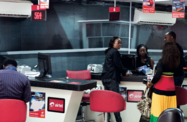Two new submarine fibre-optic cables have gone on-line in Nigeria in the past two years, with a third set to land in June. While this should eventually improve the nation’s spotty internet access, customers are still waiting to reap the benefits of increased bandwidth and lower prices. Nonetheless telecoms operators are switching over to the fourth generation (4G) platform to accommodate future expected demand for data services.
The telecoms market remains dominated by voice, with average revenue per subscriber (ARPS) from data services accounting for just 8.3% of total ARPS in 2009, according to a 2010 report by the US-based market research firm Pyramid Research, which specialises in emerging communications markets. However, increased broadband capacity from new undersea cables means that data costs will eventually fall and demand for the product will increase. In October 2010 Mobitel became the first Nigerian operator to launch a 4G WIMAX-LTE network, which allows for faster data transmission, and three other companies (Globacom, Swift Networks and Direct-on-PC) have followed in its wake.
“Telecoms companies are reassessing their data strategies to make certain that they generate considerable revenue from the internet access market in coming years,” local press reported Adebayo Oyewole, head of marketing and strategy for MainOne Cable, as saying in May 2011. MainOne Cable launched a fibre-optic cable in July 2010 and sells capacity to Nigerian telecoms operators. Originating in Portugal and with connection points in Morocco, Tenerife, Senegal and Côte d’Ivoire, the cable has a maximum capacity is 4.92 TB per second, although it is currently operating at 1.92 TB.
MainOne joined subsea cable Glo1, which was launched in the country in September 2009 by local telecoms company Globalcom, with further points in 15 other West African nations, as well as Portugal and the UK. It operates at a capacity of 2.5 TB per second, according to local press.
Additionally, a consortium led by South African operator Mobile Telephone Networks, the telecoms market leader in Nigeria, is in the midst of constructing a third undersea fibre-optic cable – the 14,000-km West Africa Cable System (WACS). In April 2010 the cable was successfully landed in South Africa, with 13 further connection points planned along the West African coast, including Nigeria in May, and a termination point in London. It will have a maximum capacity of 5.12 TB per second, the largest addition yet to the Nigerian market.
Prior to 2009 the SAT-3 cable, in which state-run telecoms firm NITEL is a stakeholder, was Nigeria’s sole source of internet connectivity, with capacity of 20 GB per second. Supply disruptions are commonplace on SAT-3 and the country lost 70% of bandwidth access in July 2009 due to cable damage. SAT-3 is also undergoing an upgrade to up its capacity to 340 GB per second. According to local press, a total of $2.24bn will have been invested in Nigeria’s fibre-optic lines by 2012.
Pyramid Research has predicted that the broadband penetration rate will rise from 3.2% in 2010 to 6.8% in 2015 as a result of the cable landings. “Telecoms infrastructure development, such as the launch of the MainOne and Glo1 undersea cables, has encouraged competition and facilitated the expansion of data networks, making them more accessible and affordable to the public,” said the research firm in April 2011.
So far, the benefits of expanded capacity have been minimal for customers. Local press reported at the end of January 2011 that bandwidth costs as much as $500 per MB, while Nigeria Internet Group, an organisation lobbying for increasing internet penetration, believes that prices should be $30-50 to maximise the country’s economic potential. Major drops in prices should be on the horizon in 2011 as all the new undersea cables begin to operate at full capacity and competition heats up among players

